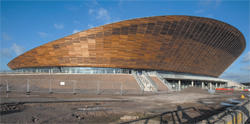It’s that time of year when writers of editorials on magazines the world over look at the news and think ‘Bugger, there’s nothing happening to have an opinion on.’ We’ll be rounding up our favourite technologies of the year on Friday, so for the last Wednesday Agenda of the 2011, I thought I’d try to take a look forward at what might be in our pages come 2012.
It’s harder than you’d think, because you come up against two truisms of technology: in some areas, innovation happens slowly, but transformative technologies often seem to come out of nowhere and quickly become ubiquitous. Twitter, for example, rocketed in 2011: slightly obscure and geeky at the end of last year, and credited with the downfall of regimes and the breakdown of the normal rules of the press twelve months later.
So we know that some things will continue at a steady pace. Up in Rosyth, Britain’s two new aircraft carriers will grow slowly, while rows rumble on over how and when they’ll be equipped. It’s possible that we’ll see some actual building work begin on new nuclear power stations, but we wouldn’t bet next month’s salary on it; more likely is a steady drip of announcements about planning permission and maybe some major equipment orders, we hope from UK suppliers. At the very least, the UK supply chain for these major projects should start to kick into gear.
Of course, the one thing that we do know will be happening next year is the London Olympics, and a visit to the Olympic Park site last week showed building work entering its final stages. Whether everything will work as it’s supposed to is, of course, another matter; we on The Engineer prefer to be optimistic. There’s some truly inspiring technology and engineering on display in Stratford as well as some striking architecture, and not enough of the stories about it have reached the public; as the sporting dramas unfold next summer, we hope that the ideas, inspiration and sheer hard work of the people who have enabled it to happen and are bringing it into homes worldwide will be appreciated.

We can expect more electric vehicles at next year’s car shows, and a continuing to-and-fro of argument over whether they are appropriate for most people’s travel needs. Jeremy Clarkson will say something outrageous about them. Most people will ignore him, but we’ll spend two weeks rebutting his claims in our comments columns. We can, however, be pretty sure that electric cars won’t have taken over our roads by this time next year. By the end of the decade? Perhaps.
By this time next year, we might know whether nuclear fusion can be sustained; the US National Ignition Facility in California hopes to complete a key run of experiments into inertial-confinement fusion with its titanic lasers. We might know whether the Higgs Boson exists. We still won’t know how Father Christmas delivers all the presents in one night, but the Quantum Theory of Santa Claus states that he’s actually a sub-atomic particle which has to travel through every point in the universe simultaneously, absorbing mince pie quanta and emitting presents. Expect an announcement from CERN shortly, and Prof Brian Cox will be along to draw a graph, possibly while wearing a silly hat.
On a less high-tech note, we at Engineer Towers have high hopes that our lifts will be fixed; if not, we will continue to develop the best-toned thighs of any technology magazine editorial team. Don’t mock, we’re five floors up.
In any case, we’d like to thank you for reading the magazine and website over the past year, and particularly for all your feedback and comments on our articles and videos. Best wishes to all our readers for Christmas and the New Year.




Glasgow trial explores AR cues for autonomous road safety
They've ploughed into a few vulnerable road users in the past. Making that less likely will make it spectacularly easy to stop the traffic for...